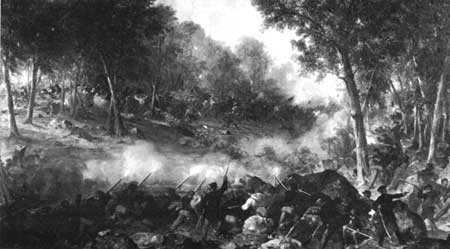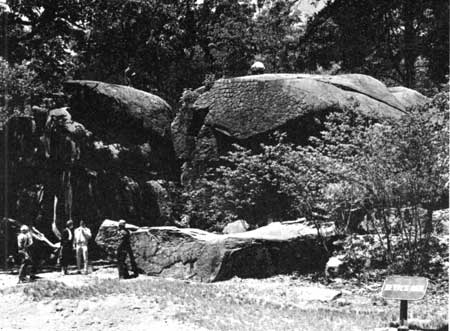|
GETTYSBURG National Military Park |
 |

Repulse of General Johnson's Confederates near Spangler's Spring
on July 3,
by Peter F. Rothermel.
Courtesy Pennsylvania
Historical and Museum Commission.
The Third Day (continued)
LEE PLANS A FINAL THRUST. General Lee must have learned by mid-forenoon, after the long hours of struggle at Culp's Hill and Spangler's Spring, that his troops could not hold the Union works which they had occupied with so little effort the previous evening. He had seen, also, that in the tremendous battling during the preceding afternoon no important gains had been made at Little Round Top and its vicinity. Longstreet had gained the advantageous ridge at the Peach Orchard and had brought his batteries forward from Pitzer's Woods to this high ground in preparation for a follow-up attack. Wright's brigade, the last unit to move forward on July 2 in the echelon attack begun by General Law, had charged across the open fields at dusk and pierced the Union center just south of the copse of trees on Cemetery Ridge. Wright's success could not be pressed to decisive advantage as the brigades on his left had nor moved forward to his support, and he was forced to retire. Again, lack of coordination in attack was to count heavily against the Confederates.
The failure to make any pronounced headway on July 2 at Culp's Hill and Little Round Top, and the momentary success of Wright on Cemetery Ridge, doubtless led Lee to believe that Meade's flanks were strong and his center weak. A powerful drive at the center might pierce the enemy's lines and fold them back. The shattered units might then be destroyed or captured at will. Such a charge across open fields and in the face of frontal and flank fire would, Lee well understood, be a gamble seldom undertaken. Longstreet strongly voiced his objection to such a move, insisting that "no 15,000 men ever arrayed for battle can take that position."

Devil's Den, a formation of large granite boulders used as defense
positions by Confederate sharpshooters.
Time now was the important element. Whatever could be done must be done quickly. Hood's and McLaws' divisions, who had fought bravely and lost heavily at Round Top and the Wheatfield, were not in condition for another severe test. Early and Johnson on the left had likewise endured long, unrelenting battle with powerful Union forces in positions of advantage. The men of Heth's and Pender's divisions had not been heavily engaged since the first day's encounter west of Gettysburg. These were the men, along with Pickett's division, whom Lee would have to count on to bear the brunt of his final great effort at Gettysburg.

|

|
|
Last Modified: Mon, Mar 4 2002 10:00:00 pm PDT |


